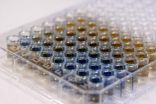(Press-News.org) When a patient is diagnosed with type 2 diabetes, the disease has usually already progressed over several years and damage to areas such as blood vessels and eyes has already taken place. To find a test that indicates who is at risk at an early stage would be valuable, as it would enable preventive treatment to be put in place.
Researchers at Lund University have now identified a promising candidate for a test of this kind. The findings have been published in the journal Cell Metabolism.
"We have shown that individuals who have above-average levels of a protein called SFRP4 in the blood are five times more likely to develop diabetes in the next few years than those with below-average levels", says Anders Rosengren, a researcher at the Lund University Diabetes Centre (LUDC), who has led the work on the risk marker.
Higher levels in diabetes patients
It is the first time a link has been established between the protein SFRP4, which plays a role in inflammatory processes in the body, and the risk of type 2 diabetes.
Studies at LUDC, in which donated insulin-producing beta cells from diabetic individuals and non-diabetic individuals have been compared, show that cells from diabetics have significantly higher levels of the protein.
Link between inflammation and diabetes explained
It is also the first time the link between inflammation in beta cells and diabetes has been proven.
"The theory has been that low-grade chronic inflammation weakens the beta cells so that they are no longer able to secrete sufficient insulin. There are no doubt multiple reasons for the weakness, but the SFRP4 protein is one of them", says Taman Mahdi, main author of the study and one of the researchers in Anders Rosengren's group.
Fivefold risk increase
The level of the protein SFRP4 in the blood of non-diabetics was measured three times at intervals of three years. Thirty-seven per cent of those who had higher than average levels developed diabetes during the period of the study. Among those with a lower than average level, only nine per cent developed the condition.
"This makes it a strong risk marker that is present several years before diagnosis. We have also identified the mechanism for how SFRP4 impairs the secretion of insulin. The marker therefore reflects not only an increased risk, but also an ongoing disease process", says Anders Rosengren.
The marker works independently of other known risk factors for type 2 diabetes, for example obesity and age.
Motivation for lifestyle changes
"If we can point to an increased risk of diabetes in a middle-aged individual of normal weight using a simple blood test, up to ten years before the disease develops, this could provide strong motivation to them to improve their lifestyle to reduce the risk", says Anders Rosengren, adding:
"In the long term, our findings could also lead to new methods of treating type 2 diabetes by developing ways of blocking the protein SFRP4 in the insulin-producing beta cells and reducing inflammation, thereby protecting the cells."
###
The research results have been published in the journal Cell Metabolism:
'Secreted Frizzled-Related Protein 4 Reduces Insulin Secretion and is Overexpressed in Type 2 Diabetes'
http://www.sciencedirect.com/science/article/pii/S1550413112004093
For more information:
Anders Rosengren, tel. +46 40 39 11 69, mobile +46 705 31 67 04
Anders.Rosengren@med.lu.se
Protein reveals diabetes risk many years in advance
2012-11-07
ELSE PRESS RELEASES FROM THIS DATE:
Persistent sync for neurons
2012-11-07
A team of Brazilian physicists working with neuroscientists studying freely behaving rats have found that their neurons often act in precise coordination over time, in a study about to be published in EPJ B. These findings stem from the work of Bruno Silva, a researcher at Bahia Federal University in Salvador, and his colleagues from other universities in the Northeastern region of Brazil, and suggest that neuronal networks' memory could be explored in the future.
Because neurons are connected with each other, acting as operational units in the brain, they can be considered ...
City birds adapt to their new predators
2012-11-07
Faced with the same threat, city and country birds do not react in the same way despite being from the same species. According to a new study, urban birds have changed their anti-predator behaviour in new environments.
When a bird is faced with a predator, its only objective is to escape. However, city birds do not react in the same way as their countryside counterparts, despite being from the same species. Urbanisation plays an influential role in their survival strategies.
To study this phenomenon, Juan Diego Ibáñez-Álamo, researcher at the University of Granada ...
Ultrasensitive photon hunter
2012-11-07
Fast and ultrasensitive optical systems are gaining increasing significance and are being used in a diverse range of applications, for example, in imaging procedures in the fields of medicine and biology, in astronomy and in safety engineering for the automotive industry. Frequently the challenge lies in being able to record high-quality images under extremely low light conditions. Modern photo detectors for image capture typically reach their limits here. They frequently work with light-sensitive electronic components that are based on CMOS (Complementary Metal Oxide ...
Dealing with power outages more efficiently
2012-11-07
Power supply is the backbone of our modern economy. Nearly every aspect of life depends on electrically-operated devices. When the flow of power stops, it is not just the lights that go out. In the supermarket, the automatic teller machines and cash registers stop working. Even telephones, radios and televisions become paralyzed. If the shortage lasts a long time the supply of hot water, gas and fuel and the functioning of respirators at intensive care units in nursing homes or at private homes is at risk.
The causes of this dreadful scenario can range from natural disasters ...
Activating the 'mind's eye' -- sounds, instead of eyesight can be alternative vision
2012-11-07
Jerusalem, Nov. 7, 2012 -- Common wisdom has it that if the visual cortex in the brain is deprived of visual information in early infanthood, it may never develop properly its functional specialization, making sight restoration later in life almost impossible.
Scientists at the Hebrew University of Jerusalem and in France have now shown that blind people – using specialized photographic and sound equipment – can actually "see" and describe objects and even identify letters and words.
The new study by a team of researchers, led by Prof. Amir Amedi of the Edmond and ...
Protected areas in East Africa may not be conserving iconic plants
2012-11-07
A new study led by researchers from the University of York suggests protected areas in East Africa are not conserving plants such as the iconic Acacia tree.
Acacia, the thorny flat-topped tree that characterises the African savannas, is an important component of ecosystem diversity. However, the researchers found that the majority of Acacia biodiversity 'hotspots' receive little protection through the protected area network, which includes national parks, nature and forest reserves. The situation, they say, may be exacerbated by climate change.
The results of the study, ...
Development of measures to prevent wine indispositions
2012-11-07
Biogenic amines may be one of the factors responsible for symptoms such as headaches, gastro-intestinal disorders, shortness of breath, fall in blood pressure, and even unconsciousness and cardiac arrhythmia in severe cases. Histamine, one of the best known members of this group, can cause serious physical problems. Biogenic amines can be produced in the body by natural metabolic activities but are also ingested in larger quantities with food. They play a special role in microbiologically produced food such as wine, beer, cheese, and sauerkraut. In a joint project Johannes ...
Recent studies bring fossils and genes together to piece together evolutionary history
2012-11-07
Paleontology, with its rocks and fossils, seems far removed from the world of developmental genetics, with its petri dishes and embryos. Whereas paleontology strives to determine "What happened in evolution?", developmental genetics uses gene control in embryos to try to answer "How did it happen?" Combined, the two approaches can lead to remarkable insights that benefit both fields.
In the current issue of the Journal of Vertebrate Paleontology, Hans Thewissen, Ingalls-Brown Professor at Northeast Ohio Medical University (NEOMED), and his colleagues review recent studies ...
New method could help communities plan for climate risk
2012-11-07
CAMBRIDGE, Mass. -- Climate scientists cannot attribute any single weather event — whether a drought, wildfire or extreme storm — to climate change. But extreme events, such as Hurricane Sandy, are glimpses of the types of occurrences the world could be more vulnerable to in the future. As the devastation left by Sandy continues to reverberate, decision-makers at every level are asking: How can we be better prepared?
MIT researchers have developed a new tool to help policymakers, city planners and others see the possible local effects of climate change. Its regional projections ...
Synthetic biofilter wins through to the top 'Sweet 16' in Boston
2012-11-07
This press release is available in German.
Months of painstaking work in the laboratory at Bielefeld University's Center for Biotechnology (CeBiTec) have paid off: the 15 students participating in this year's 'international Genetically Engineered Machine competition' (iGEM) at the Massachusetts Institute of Technology (MIT) have good reason to celebrate. The goal of their project was to develop a biological filter that removes estrogen from drinking water. It was a success: they managed to produce enzymes that break down the hormone. On Monday 5 November, the competition ...





